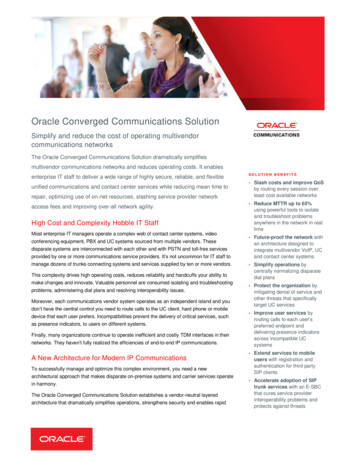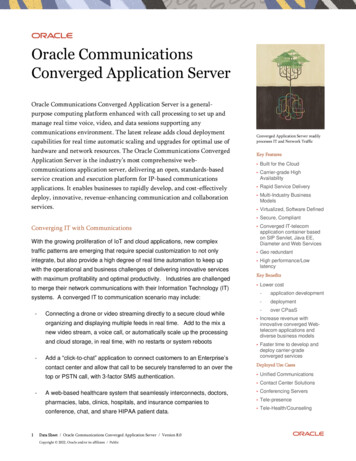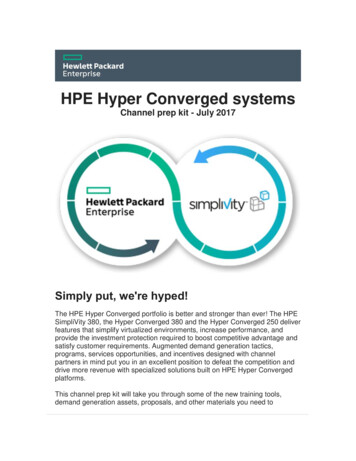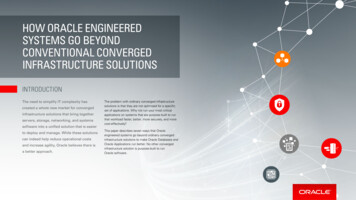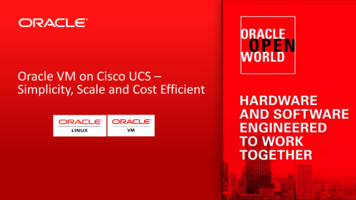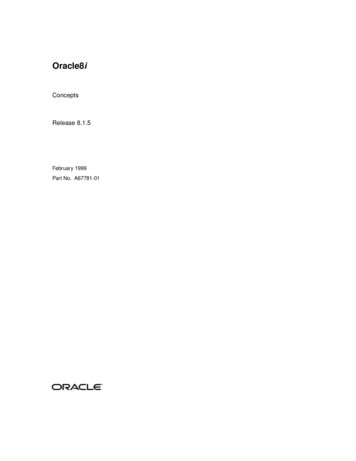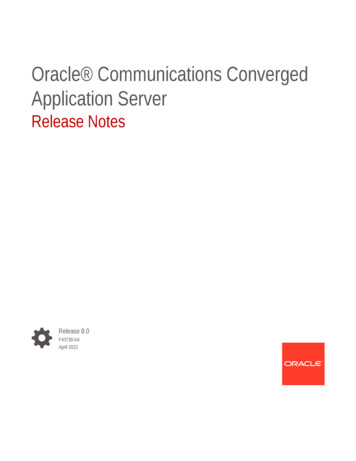
Transcription
Oracle Communications ConvergedApplication ServerRelease NotesRelease 8.0F43730-04April 2022
Oracle Communications Converged Application Server Release Notes, Release 8.0F43730-04Copyright 2016, 2022, Oracle and/or its affiliates.This software and related documentation are provided under a license agreement containing restrictions onuse and disclosure and are protected by intellectual property laws. Except as expressly permitted in yourlicense agreement or allowed by law, you may not use, copy, reproduce, translate, broadcast, modify, license,transmit, distribute, exhibit, perform, publish, or display any part, in any form, or by any means. Reverseengineering, disassembly, or decompilation of this software, unless required by law for interoperability, isprohibited.The information contained herein is subject to change without notice and is not warranted to be error-free. Ifyou find any errors, please report them to us in writing.If this is software or related documentation that is delivered to the U.S. Government or anyone licensing it onbehalf of the U.S. Government, then the following notice is applicable:U.S. GOVERNMENT END USERS: Oracle programs (including any operating system, integrated software,any programs embedded, installed or activated on delivered hardware, and modifications of such programs)and Oracle computer documentation or other Oracle data delivered to or accessed by U.S. Government endusers are "commercial computer software" or "commercial computer software documentation" pursuant to theapplicable Federal Acquisition Regulation and agency-specific supplemental regulations. As such, the use,reproduction, duplication, release, display, disclosure, modification, preparation of derivative works, and/oradaptation of i) Oracle programs (including any operating system, integrated software, any programsembedded, installed or activated on delivered hardware, and modifications of such programs), ii) Oraclecomputer documentation and/or iii) other Oracle data, is subject to the rights and limitations specified in thelicense contained in the applicable contract. The terms governing the U.S. Government’s use of Oracle cloudservices are defined by the applicable contract for such services. No other rights are granted to the U.S.Government.This software or hardware is developed for general use in a variety of information management applications.It is not developed or intended for use in any inherently dangerous applications, including applications thatmay create a risk of personal injury. If you use this software or hardware in dangerous applications, then youshall be responsible to take all appropriate fail-safe, backup, redundancy, and other measures to ensure itssafe use. Oracle Corporation and its affiliates disclaim any liability for any damages caused by use of thissoftware or hardware in dangerous applications.Oracle, Java, and MySQL are registered trademarks of Oracle and/or its affiliates. Other names may betrademarks of their respective owners.Intel and Intel Inside are trademarks or registered trademarks of Intel Corporation. All SPARC trademarks areused under license and are trademarks or registered trademarks of SPARC International, Inc. AMD, Epyc,and the AMD logo are trademarks or registered trademarks of Advanced Micro Devices. UNIX is a registeredtrademark of The Open Group.This software or hardware and documentation may provide access to or information about content, products,and services from third parties. Oracle Corporation and its affiliates are not responsible for and expresslydisclaim all warranties of any kind with respect to third-party content, products, and services unless otherwiseset forth in an applicable agreement between you and Oracle. Oracle Corporation and its affiliates will not beresponsible for any loss, costs, or damages incurred due to your access to or use of third-party content,products, or services, except as set forth in an applicable agreement between you and Oracle.
ContentsMy Oracle SupportRevision History1New FeaturesFeatures in Patches2Deprecated Features3Software Versions4Known Issues1-1iii
My Oracle SupportMy Oracle SupportMy Oracle Support (https://support.oracle.com) is your initial point of contact for allproduct support and training needs. A representative at Customer Access Support(CAS) can assist you with My Oracle Support registration.Call the CAS main number at 1-800-223-1711 (toll-free in the US), or call the OracleSupport hotline for your local country from the list at l. When calling, make the selections in the sequence shown belowon the Support telephone menu:1.Select 2 for New Service Request.2.Select 3 for Hardware, Networking, and Solaris Operating System Support.3.Select one of the following options: For technical issues such as creating a new Service Request (SR), select 1. For non-technical issues such as registration or assistance with My OracleSupport, select 2.You are connected to a live agent who can assist you with My Oracle Supportregistration and opening a support ticket.My Oracle Support is available 24 hours a day, 7 days a week, 365 days a year.Emergency ResponseIn the event of a critical service situation, emergency response is offered by theCustomer Access Support (CAS) main number at 1-800-223-1711 (toll-free in the US),or call the Oracle Support hotline for your local country from the list at l. The emergency response providesimmediate coverage, automatic escalation, and other features to ensure that thecritical situation is resolved as rapidly as possible.A critical situation is defined as a problem with the installed equipment that severelyaffects service, traffic, or maintenance capabilities, and requires immediate correctiveaction. Critical situations affect service and/or system operation resulting in one orseveral of these situations: A total system failure that results in loss of all transaction processing capability Significant reduction in system capacity or traffic handling capability Loss of the system's ability to perform automatic system reconfiguration Inability to restart a processor or the system Corruption of system databases that requires service affecting corrective actions Loss of access for maintenance or recovery operations Loss of the system ability to provide any required critical or major troublenotificationiv
My Oracle SupportAny other problem severely affecting service, capacity/traffic, billing, and maintenancecapabilities may be defined as critical by prior discussion and agreement with Oracle.Locate Product Documentation on the Oracle Help Center SiteOracle Communications customer documentation is available on the web at the Oracle HelpCenter (OHC) site, http://docs.oracle.com. You do not have to register to access thesedocuments. Viewing these files requires Adobe Acrobat Reader, which can be downloaded athttp://www.adobe.com.1.Access the Oracle Help Center site at http://docs.oracle.com.2.Click Industries.3.Under the Oracle Communications sub-header, click the Oracle Communicationsdocumentation link.The Communications Documentation page appears. Most products covered by thesedocumentation sets appear under the headings "Network Session Delivery and ControlInfrastructure" or "Platforms."4.Click on your Product and then Release Number.A list of the entire documentation set for the selected product and release appears.5.To download a file to your location, right-click the PDF link, select Save target as (orsimilar command based on your browser), and save to a local folder.Access to Oracle SupportOracle customers that have purchased support have access to electronic support through MyOracle Support. For information, visit http://www.oracle.com/pls/topic/lookup?ctx acc&id infoor visit http://www.oracle.com/pls/topic/lookup?ctx acc&id trs if you are hearing impaired.v
Revision HistoryRevision HistoryTable 1Revision HistoryDateRevisionDecember 2021 Initial releaseRemoved Hardware Requirementssection.March 2022 Updates for Diameter load balancing inpatch 32772852April 2022 Updates for SCTP multihoming in patch32856203vi
1New FeaturesRelease 8.0 of the Oracle Communications Converged Application Server (OCCAS) supportsthe following new features.Cloud Native EnvironmentsYou can orchestrate cloud native OCCAS deployements using Kuberenetes with Dockercontainers. Docker containers bundle software and their dependencies to allow for quickdeployment of bundled applications on cloud native environments. See the CloudDeployment Guide.REST APIs for Config and Runtime MBeansYou can use the new REST API to access the Config and Runtime MBeans. See theDeveloper Guide.Dynamic Cluster for On-PremDynamic Cluster domains help scale up and scale down on-prem deployments.Third-Party ToolsThe cloud native OCCAS may be used with two sets of third-party monitoring tools: The EFK stack for monitoring logs Prometheus and Grafana for monitoring KPI metricsThe EFK stack is the combination of Elasticsearch, FluentD, and Kibana working together tocentralize log files for easy monitoring. FluentD gathers logs files from multiple nodes andsends them to Elasticsearch, which stores and indexes them, while Kibana provides the frontend web interface.The cloud native OCCAS can also use the WebLogic Monitoring Exporter to exportPrometheus-compatible metrics that are then exposed to Grafana, which visualizes themetrics over time to provide futher insights into the data.See the Cloud Deployment Guide.Features in PatchesThe following features are available in patches for OCCAS 8.0.Table 1-1Features in PatchesFeatureAvailable in PatchDiameter Load Balancing32772852SCTP Multihoming328562031-1
2Deprecated FeaturesThe following features have been deprecated in release 8.0.Proxy RegistrarConfiguring proxy registrars is no longer supported in release 8.0 and later.2-1
3Software VersionsUse the following software versions when deploying OCCAS.Table 3-1Software VersionsSoftwareVersionWebLogic Server14.1.1.0.0Java Oracle Linux7.8 and 7.91.8.0 301-b0911.0.123-1
4Known IssuesThe following table lists the known issues in this release and the workaround for each issue.Table 4-1Known Bugs in this ReleaseBugIDDescription20742195The RFC 6665 specification states that proxyservers that do not add Record-Route headerfields to the initial SUBSCRIBE request are thenprohibited from adding Record-Route headerfields to any associated NOTIFY requests.However, Converged Application Server does notcheck for Record-Route header fields in NOTIFYrequests.Developers creating applications for ConvergedApplication Server should not callProxy.setRecordRoute(true), orproxyBranch.setRecordRoute(true) when handlingnotify requests that did not already set theRecord-Route header field in a Register request.20318523 / 20550145Associating too many sessions with a single keycauses performance problems.When using the new SipApplicationSessionaddIndexKey() method, ensure that the sessionkeys you create are unique to subscribers. Thisstrategy helps you avoid performance degradationproblems.If your session keys are unique to subscribers andlarge reads still cause performance problems, trypaging the result when iterating over the readindex record.If your session keys are unique to subscribers andlarge writes still cause performance problems, trysplitting large index records into smaller "chunks."That way you do not need to deserialize the fullrecord to add or remove values from it.18066581Deploying SIP applications that declareServletContainerInitializer can in some casescause the onStartup() method to be called twice.You can prevent this by using thewlss.initializer.classes system property to specifyand limit SIP specific container initializers.4-1
Chapter 4Table 4-1(Cont.) Known Bugs in this ReleaseBugIDDescription15957604Applications should not try to inject a resourcewith the same name in both a field and method.For example, injecting a SipFactory resource withthe same name into both the setMySipFactorymethod and the mySipFactory field is notsupported.This behavior is prohibited by JavaEEspecification EE.5.2.3, but this release ofConverged Application Server does notspecifically check for this error.Violating this rule can cause unexpected behavior.4-2
Infrastructure" or "Platforms." 4. . Release 8.0 of the Oracle Communications Converged Application Server (OCCAS) supports the following new features. Cloud Native Environments You can orchestrate cloud native OCCAS deployements using Kuberenetes with Docker containers. Docker containers bundle software and their dependencies to allow for quick

